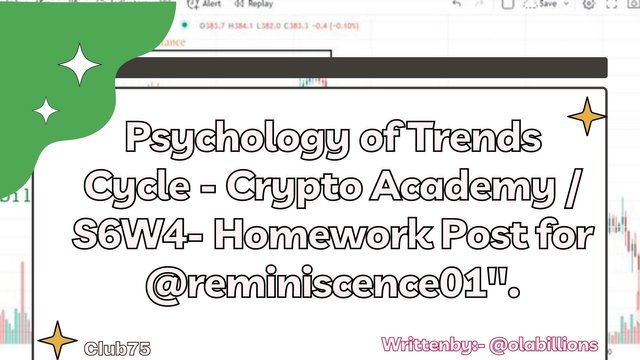

Explain your Understanding of the Dow Jones Theory. Do you think Dow Jones Theory is Important in technical analysis?
The Dow theory is a theory that is used in the financial markets to show when the market is in an uptrend or downtrend.
He stated that if an average moves beyond a critical level either high or low, then the market is trending in the direction in which the average moved beyond, and if another average follows suit, then the trend is confirmed.
He believed that one can know the overall conditions of the market and use those conditions to identify trends in the market.
The theory follows some principles. Everything is discounted by the market, there are mainly three types of market trends, those trends have their phases and for the trend to be confirmed, there must be confirming indices, and indicators with high volume, and the trend is on until there is a clear reversal.
Certainly, the Dow theory is important in technical analysis because by analyzing the market and the conditions of the market, we can get a good idea of the direction of the trend of price.

In your own words, explain the psychology behind the Accumulation and Distribution phases of the market. (Screenshots required).
The price of an asset moves in an uptrend and in a downtrend. These are the ideal movement of price as it is when traders can be profitable.
During the start of an uptrend, a trader can place a buy entry to enable his profit from the uptrend. Likewise in a downtrend traders can place a sell entry to profit from the down.
But sometimes before the uptrend or downtrend takes place some activities usually occur. These activities are usually originated by the big players because they have the resources to move the market.
I shall be discussing these activities next.
Accumulation Phase
The accumulation phase is usually found at the bottom of the chart after a downtrend. At this point, the big players who distributed the asset by selling it at a high price and caused a lot of selling interest from retail traders who join the trend make the price move lower start to close their position for the asset at a low price.
After a lot of selling activities from both retail traders and the big players, the big players then begin to take their profits by closing their sell entries. The price starts to move slowly because their positions are large enough which affects the price.
Retail traders who have no clue about what is going on keep on selling at a loss, thinking the price would continue to go down, so they sell at a loss. At this point, the big players buy the asset from the retail traders, and because of their enormous buying power, the price begins to increase.
This phenomenon makes the price begin to move sideways or in a "range". So during the period of the big player's transition from selling to buying and the retail traders still selling, we can see it on the chart as the price begins to move sideways rather than continuing its downward movement.
Then as the big players continue to buy the asset, the price begins to rise. The price begins to pique buyers' interest as they come in and push the price up.
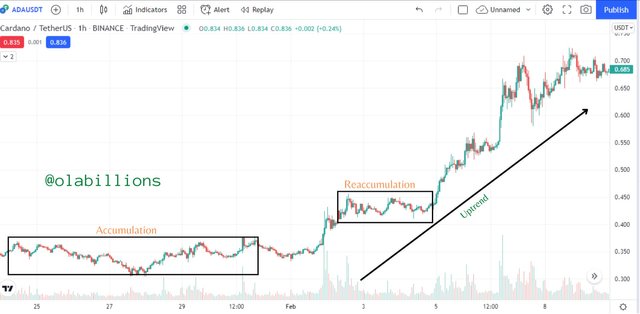 Tradingview
Tradingview It usually has a formation on the chart and when it is completed, we then see a trend reversal and subsequently a breakout from the accumulation phase (which is also a resistance level).
We can see how the price came down then entered the accumulation phase, before turning around to rise up again.
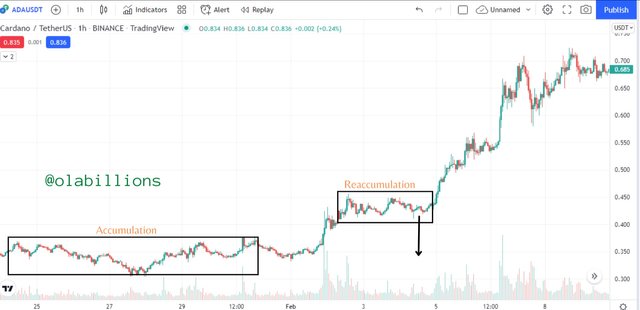 Tradingview
Tradingview As the price moves upwards, it gets to a point where it begins to move sideways or in a "range". That is because those that opened buy positions early, start to take some profits by closing their buy positions. This is known as Re-accumulation.
It is formed in the upward movement and can confuse retail traders to think that the uptrend is getting weak. So the retail traders have to be careful, so as not to fall victim to wrong moves. Except the price breaks out from the bottom of the re-accumulation phase, wait for it to break out from the top so that it can continue its upward movement. This phenomenon is known as a Trend continuation.
Distribution Phase
The distribution phase is usually found at the top of the chart after an uptrend. At this point, the big players who started accumulating the asset by buying it at a low price and causing a lot of buying interest from retail traders who then joins the trend thereby pushing the price upwards start to close their position for the asset at a high price.
After a lot of buying activities from both retail traders and the big players, the big players then begin to take their profits by closing their buy entries. The price starts to move slowly because their positions are large enough which affects the price.
Retail traders who have no clue about what is going on, so they keep on buying at a loss thinking the price would continue to go up, so they buy at a loss. At this point, the big players sell the asset to the retail traders, and because of their enormous selling power, the price begins to decrease.
This phenomenon makes the price begin to move sideways or in a "range". So during the period of the big player's transition from buying to selling and the retail traders still buying, we can see it on the chart as the price begins to move sideways rather than continuing its upward movement.
Then as the big players continue to sell the asset, the price begins to fall. The price begins to pique sellers' interest as they come in and push the price down.
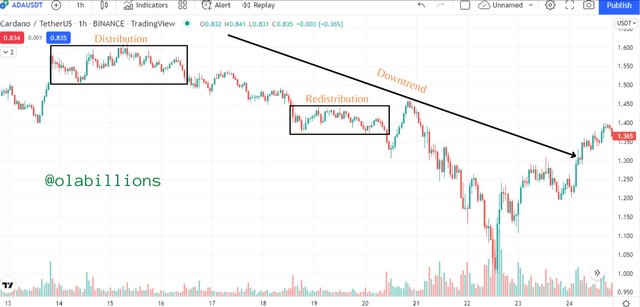 Tradingview
Tradingview It usually has a formation on the chart and when it is completed, we then see a trend reversal and subsequently a breakout from the distribution phase (which is also a support level).
We can see how the price went up and then entered the distribution phase, before turning around to fall again.
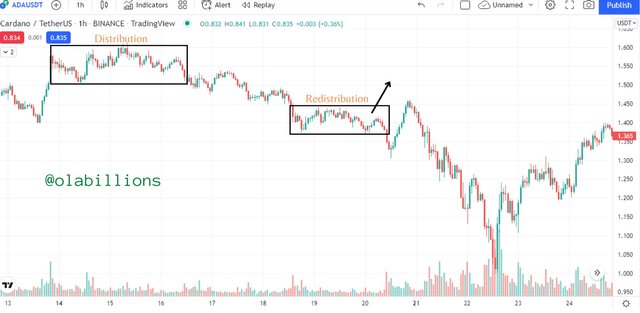 Tradingview
Tradingview As the price moves downwards, it gets to a point where it begins to move sideways or in a "range". That is because those that opened sell positions early, start to take some profits by closing their sell positions. This is known as Re-distribution.
It is formed in the downward movement and can confuse retail traders to think that the downtrend is getting weak. So the retail traders have to be careful, so as not to fall victim to wrong moves. Except the price breaks out from the top of the re-distribution phase, wait for it to break out from the bottom so that it can continue its downward movement. This phenomenon is known as a Trend continuation.

Explain the 3 phases of the market and how they can be identified on the chart.
In the markets, there are phases that always occur. These phases are the Bullish, Bearish, and Sideways phases. They are closely related to a trend because the price moves in trends and this is the profitable period for traders, also the trend moves in 2 directions, either up or down.
However, there are times when the price moves sideways or in a "range".
These phases have uniques attributes and help traders to identify key points during the life of each phase.
The phases can be identified using different methods such as the use of technical indicators, trendlines, market structure, price action, technical analysis charts, etc.
Amongst all these methods of identifying a phase, the market structure is the most suitable as it gives a clearer and better visualization of the price movement and gives key levels for entries and exits.
Bullish Phase
In the bullish phase, the price is moving in an uptrend. As the price is moving in the uptrend, it doesn't just go up in a straight line or diagonally, it goes up with pullbacks or retracement at different points.
By using the market structure, we can see these points and identify them. The points created are labeled higher highs and higher lows. The higher highers are created by the upward momentum at which the price is moving, and are a direct result of the effect of the demand for the asset. The higher lows on the other hand are the pullbacks or the retracement that occurs during the upward movement of the price and are caused by the effects of profit-taking at different high points.
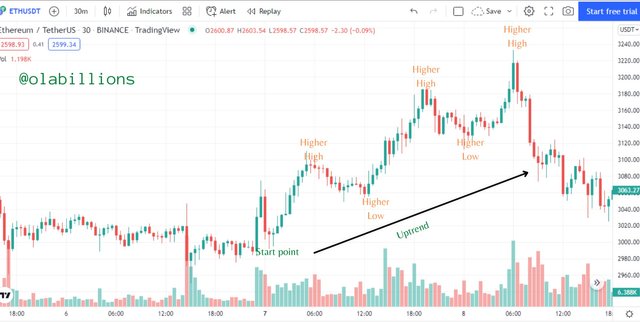 Tradingview
Tradingview In the chart above, we can see a clear example of an uptrend. From the start point which is the low point, the price went up, leading to a higher high, then it retraced, leading to a higher low. The previous higher high is lower than the recent higher high, likewise, the previous higher low is lower than the recent higher low.
Bearish Phase
In the bearish phase, the price is moving in a downtrend. As the price is moving in the downtrend, it doesn't just go down in a straight line or diagonally, it goes down with pullbacks or retracement at different points.
We can also use market structure to see these points and identify them. The points are labeled lower lows and lower highs. The lower lows are created by the downward momentum at which the price is moving, and are a direct result of the effect of the supply of the asset. The lower highs on the other hand are the pullbacks or the retracement that occurs during the downward movement and are caused by the effects of profit-taking at different low points.
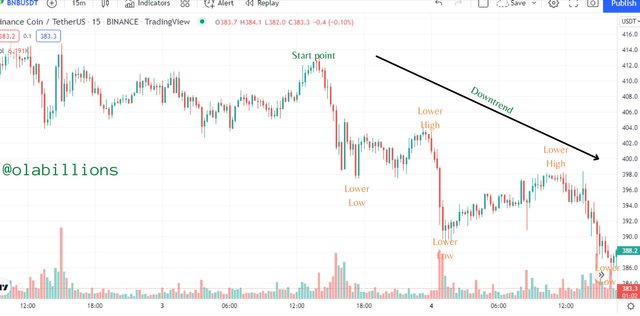 Tradingview
Tradingview In the chart above, we can see a clear example of a downtrend. From the start point which is the high point, the price went down, leading to a lower low, then it retraced, leading to a lower high. The previous lower low is higher than the recent lower low, likewise, the previous lower high is higher than the recent lower high.
Sideways Phase
In the sideways phase, the price is moving within a range. That is why it is usually called a ranging movement. This period is regarded as an equilibrium period as the demand and supply of the asset are very close.
Within this range, the price has an upper limit the price can reach, known as resistance, and a lower limit the price can reach, known as support. As the price move within this range, the price neither goes up (upward movement) nor goes down (downward movement), rather it moves to the side within the range.
It can occur at the end of a trend, either at the top or at the bottom, as per accumulation or distribution phases, it can also happen during a trend. When it occurs, a breakout is expected. And depending on the direction of the price breakout, we can have a trend reversal or a trend continuation.
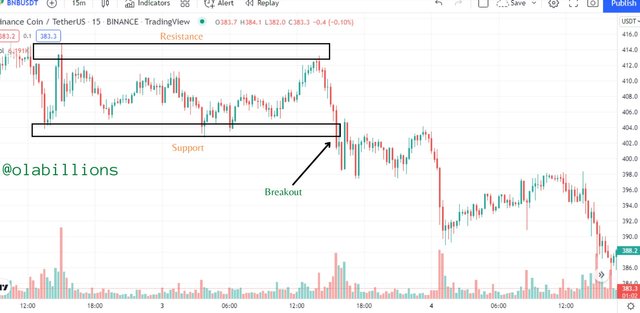 Tradingview
Tradingview In the image above, we can see the range as it formed. The price moved sideways from left to right within the range. The range had the support and resistance levels, the price broke out from the support level and moved in a downtrend.

Explain the importance of the Volume indicator. How does volume confirm a trend? Do this for the 3 phases of the market (Screenshots required).
The volume indicator is an important indicator as it shows the level of activity of traders in the market which affects the momentum at which the price moves in a direction. It shows how active the market is and how the price behaves at different phases.
It is made up of two colors of bars; green and red. The green and red bars increase and decreases to show the level of activity of the traders. The volume indicator increases when the price is moving in a certain direction whether up or down and it shows that the momentum of the price is in that direction, and decreases when the price is in a range or has a pullback/retracement which shows there is no momentum in the price.
When the price is in a trend, the volume indicator increases and becomes high either for an uptrend or downtrend which shows that the momentum of the price is in the uptrend or downtrend. But when the price retraces, the volume indicator decreases which shows that there is no momentum for the price to move in the retracement direction.
When the price is in a range (accumulation/distribution phase), the volume indicator decreases and becomes low showing no momentum of the price to move in any direction. But when the price breaks out and starts to move in a particular direction the volume bars increases, showing that there is an increase in the momentum for the price to move in that specific direction.
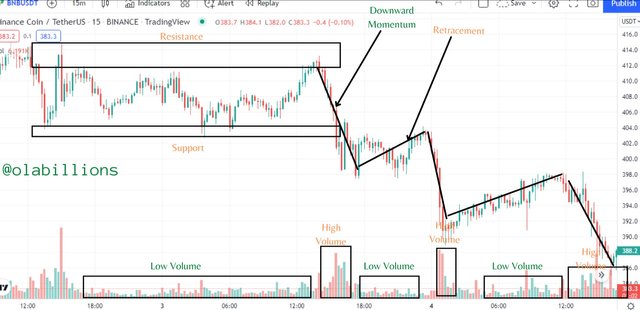 Tradingview
Tradingview We can see the relationship between the volume indicator and the movement of price. When the price was in a range, the volume indicator was low. But when the price hit the resistance level for the last time before going downwards and breaking past the support level in the process, the volume indicator was high with high red bars which shows that the momentum of the price is downwards.
Again, during the downtrend, as the price retraced, the volume of the indicator was low. But after the retracement, as the price continued its downwards movement, the volume indicator increased for the red bars which showed that the price is continuing its downward momentum. This occurrence happened for the next retracement and downward movement.
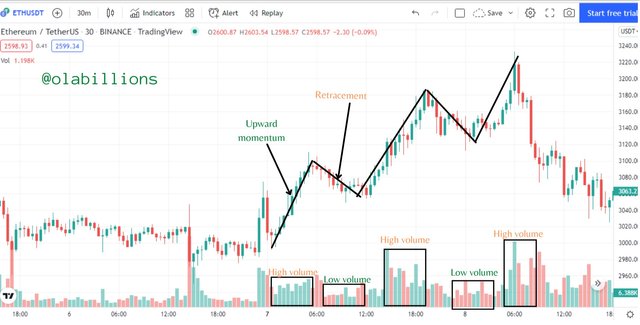 Tradingview
Tradingview We can also see on the chart above in the uptrend how the volume indicator affected it. As the price moved up, the was high volume, but when the price retraced, the volume reduced. This occurrence happened every time the price went up. The high volume bars showed that the price was moving in the upward momentum.

Explain the trade criteria for the three phases of the market. (show screenshots)
In order to get better results when performing trading operations at any market phase, there are some criteria to follow.
Criteria for a Bullish Trend
During an uptrend, let there be a clear market structure that is supported by the volume indicator. At the time the price retraces to a low point thus forming a low price for a buy entry, and as it starts to move back in the uptrend, place a buy position using the formation of a bullish candlestick. Also, look at the volume indicator and make sure that the green bars are high to show that the momentum of the price is in the uptrend.
Then you place your stop loss below the low point of the retracement and your take profit at a ratio of 1:2 or 1:3.
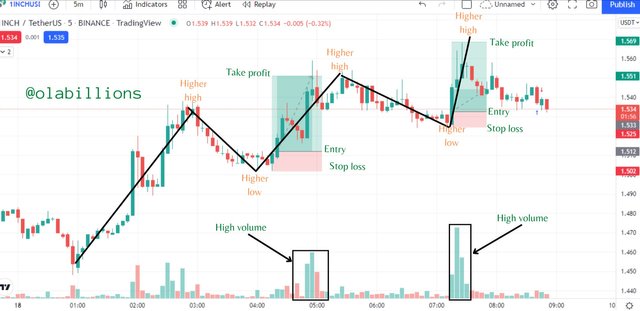 Tradingview
Tradingview We can see in the image above that there was a clear market structure which shows that the price was in an uptrend with higher highs and higher lows. Then the price retraced and formed low points. We can also see the volume indicator during the retracements as they were low and during the trend momentum as they were high.
Buy entries were made at the different low points and the trade setups were put in place.
Criteria for a Bearish Trend
During a downtrend, let there be a clear market structure that is supported by the volume indicator. At the time the price retraces to a high point thus forming a high price for a sell entry, and as it starts to move back in the downtrend, place a sell position using the formation of a bearish candlestick. Also, look at the volume indicator and make sure that the red bars are high to show that the momentum of the price is in the downtrend.
Then you place your stop loss above the high point of the retracement and your take profit at a ratio of 1:2 or 1:3.
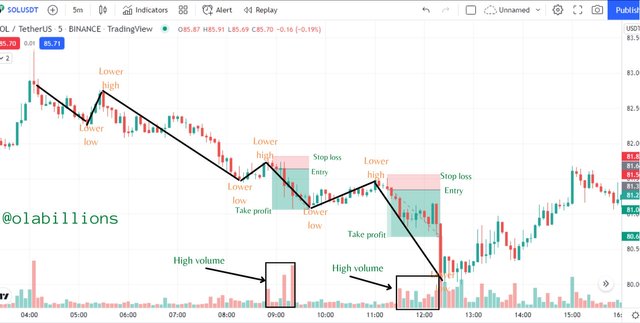 Tradingview
Tradingview We can see in the image above that there was a clear market structure which shows that the price was in a downtrend with lower lows and lower highs. Then the price retraced and formed high points. We can also see the volume indicator during the retracements as they were low and during the trend momentum as they were high.
Sell entries were made at the different low points and the trade setups were put in place.
Criteria for a Sideways Movement
Sideways movement happens because the price moves within a support and resistance limit or range. Because of this, we have the possibility of opening two or more positions during its movement in this limit or range.
Therefore, when the price hits the support level a buy entry is placed, with the stop loss placed just below the support level, and the take profit set at the resistance level.
Likewise, when the price hits the resistance level a sell entry is placed, with the stop loss placed just above the resistance level, and the take profit set at the support level.
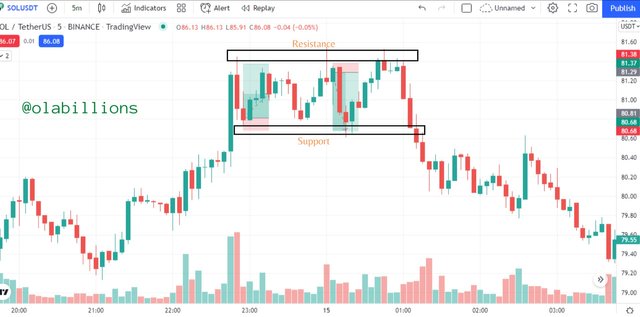 Tradingview
Tradingview We can see in the image above that the price was in a range of moving sideways, within the support and resistance levels. So at the point where the price hit the support level, a buy entry is placed with the required trade setup, likewise, when the price hit the resistance level, a sell entry is placed with the required trade setup in place.

With the Trade criteria discussed in the previous question, open a demo trade for both Buy/ Sell positions.
Buy Entry
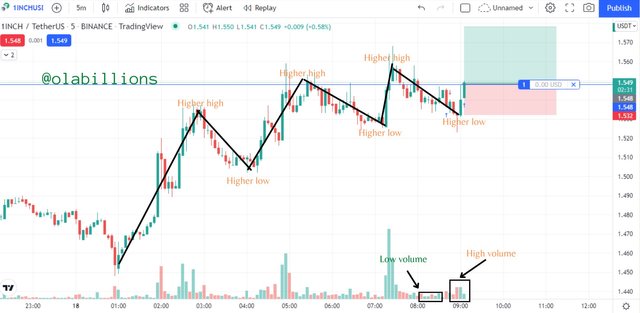 Tradingview
Tradingview The image above is a 5 min chart of 1INCHUSDT. We can see in the chart that there was a clear market structure which shows that the price was in an uptrend with higher highs and higher lows. Then the price retraced and formed low points.
At the most recent higher low, when the price began its momentum in the upward movement, a buy entry was placed using the second bullish candlestick with the stop loss below the higher low point and the take profit placed at a ratio of 1:2.
We can also see that at the continuation of the price in the momentum of the trend, there were high green bars to indicate a bullish momentum of the price.
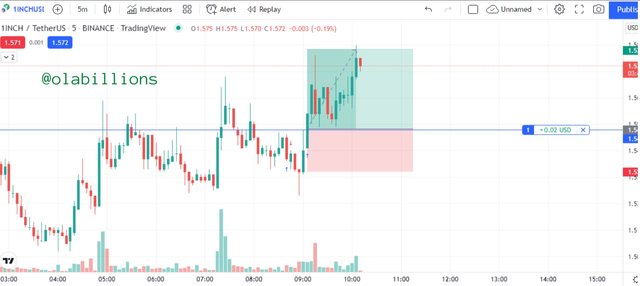 Tradingview
Tradingview This is how the price moved from the open point of the entry.
 Tradingview
Tradingview This is the trading history to show the demo trade.
Sell Entry
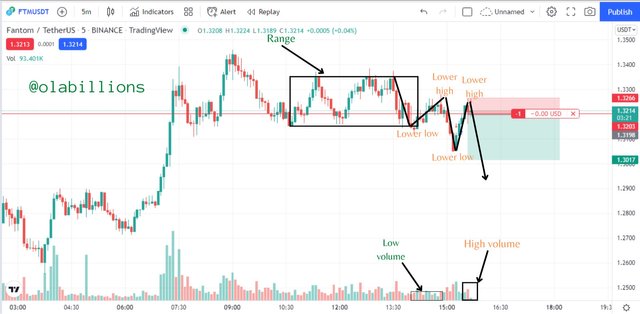 Tradingview
Tradingview The image above is a 5 min chart of FTMUSDT. We can see in the chart that there was a clear market structure after the price come out of a price range and started to move in a downtrend with lower lows and lower highs. Then the price retraced to a formed high point.
At the most recent lower high, when the price began its momentum in the downward movement, a sell entry was placed using the second bearish candlestick with the stop loss above the lower high point and the take profit placed at a ratio of 1:2.
We can also see that at the continuation of the price in the momentum of the trend, there were high red bars to indicate a bearish momentum of the price.
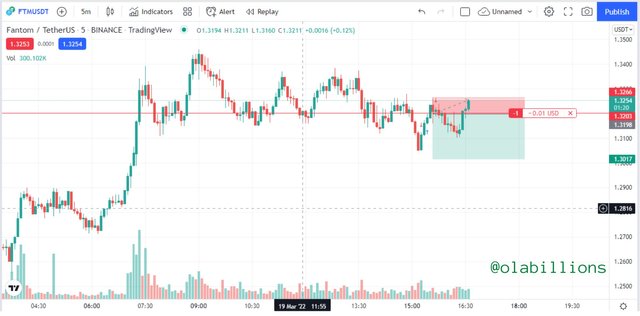 Tradingview
Tradingview This is how the price moved from the open point of the entry.
 Tradingview
Tradingview This is the trading history to show the demo trade.

Conclusion.
Trading is a very risky venture that anyone can go into especially beginners, that's why it is good for traders to have an understanding of the psychology of market trend cycles. By having a good understanding of the psychology of the trend cycles any trader can determine what is happening in the market and what they can do to better position themselves in the market.
It makes them know the accumulation and the distribution phases, the trends to follow after these phases. They also get to understand the trends that take place in the market and the time the price is in a range. They can use different methods to spot the trends but using the market structure is best.
However, it is important that using only one method for trading is risky, therefore it is paramount that traders make use of more than one trading method, one for signals and the other for confirmation. Another instance they should be very careful is when trading sideways movement. They should be careful so as not to be affected by a breakout.
Hello @olabillions, I’m glad you participated in the 4th week Season 6 at the Steemit Crypto Academy. Your grades in this Homework task are as follows:
Recommendation / Feedback:
Thank you for participating in this homework task.
Downvoting a post can decrease pending rewards and make it less visible. Common reasons:
Submit